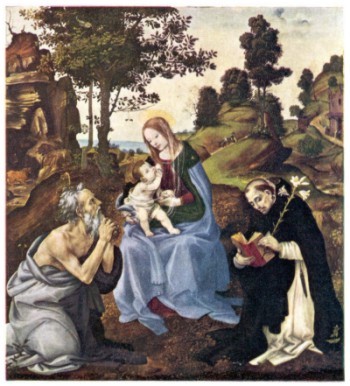Nursing Mother: Pagan and Christian
Nursing Mother: Pagan and Christian
Q: Can you provide me with information on how the pagan literary motif of the nursing mother was adapted to refer to the Virgin Mary, and whether there were many artistic or literary depictions of this scene in late Medieval Europe?
A: A fascinating topic especially because of its pre-Christian and other literary ramifications. The whole theme -- in the Christian era -- seems to be a cluster theme beginning with Luke 11, 27f, and used for different purposes by the Fathers: Irenaeus as Ecclesia-mother nursing or lactans (see: Adv. Haer. II, 24 1, PG 7, 966) or Augustine to signify Old and New Testament (see, In Ep. adv. Parrh. 3,1, PL 35, 1998). The same Augustine refers several times to milk, mother's milk. He calls it lac spiritualis gratiae but also lac pietatis et misericordiae (see: PL 36, 827, also Salzer, 496f.).
 The Virgin and Child
The Virgin and Child
Filippino Lippi, (1457?)
In the Confessions there are at least two passages comparing mother milk and heavenly consolation (Conf. I, 6 and III, 4). In PL 185, 878 we find an even more interesting passage by Augustine: "Hinc pascor a vulnere; hinc lator ab ubere. Positus ni medio quo me vertans nescio." Placed between Christ's lateral wound and Mary's breast he cannot decide where to receive nourishment from. The so called lactatio Augustini and Bernardi are quite well known motifs in sacred art. The first of these lactatio representations purportedly goes back to the 4th century (sarcophagus fragment Wilpert, Sarc. II, tabl. 221, 3). It can be traced with certitude to the seventh century (Saggarah image in E. Guibell, Exavation at Sag., Kairo 1907, tabl. 40).
Several of the likely ancestors are Mother Goddesses, in particular the nursing Isis. Other expressions in the same cluster are related to Mary's petitioning mercy of God the Father, habitually in company with Jesus. He points to the lateral wound whereas Mary holds her bare breast. Here are some known examples: -- Konrad Witz, painting on panel, ~1450, Basel: The suffering servant and Mary interceding with God, actually kneeling at his throne, Mary holding the hand of what looks like a minuscule nun.-- Illumination, 1440-1450. Turin. Same postures, the two kneeling right and left of God the Father.-- Filippino Lippi, painting on panel, 1495, Munich. Again, the Redeemer and Mary interceding on earth while God the Father is looking down from Heaven. In this painting Mary does not bare her breast but points with her right hand to the earth in need of mercy. -- Holbein the older, painting on panel, 1508, Augsburg. The Father in Heaven holds a sword, right and left of him Jesus and Mary. The latter offers her bare breast. Mary's wisdom in the form of a stream of milk is not only directed to saints (St. Bernard, in particular) but also as mercy to the poor souls (Boll A. 2, 1908, 397). Lactatio has the meaning of admission into filiation and blessings related to it. It is not only Mary who is represented nursing but also Church, nature, grammar and poetry, philosophy. Caritas, in particular. Caritas Romana, is pictured nursing two children.
All About Mary includes a variety of content, much of which reflects the expertise, interpretations and opinions of the individual authors and not necessarily of the Marian Library or the University of Dayton. Please share feedback or suggestions with marianlibrary@udayton.edu.
